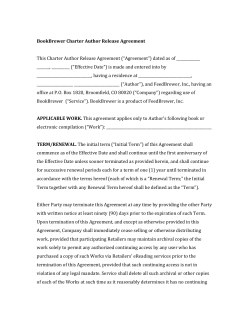
How to Beat the Omnichannel Challenge: A Recipe for Higher Growth
How to Beat the Omnichannel Challenge: A Recipe for Higher Growth A PlumSlice White Paper prepared for High-Velocity Growth: The Retail & Consumer Goods Executive Summit April 28-29, 2014 How to Beat The Omnichannel Challenge: A Recipe for Higher Growth How do you engage customers in 2014 when the customers are moving rapidly between smartphones, tablets, physical stores and other shopping channels? As this trend gains even more traction, consistency and synchronization of the multichannel shopping experience is a critical factor in success. Data analytics shows there is a continuing shift from bricks and mortar site-based purchases to online, with mobile fueling the growth. Mobile devices generated a record number of sales in the 2013 holiday season: of the $601.8 billion in sales, $95.7 billion was generated online, and 16.6% of these sales were mobile. Looking ahead to 2014, online sales are expected to continue a solid 9 to 12 percent growth, mapping the estimated 10.3 percent gain in 2013. Mobile will continue to grow: by 2017, eMarketer predicts retail sales made on mobile devices will exceed $100 billion. While mobile is gaining a larger market share, it is clear retailers have a long ways to go in achieving an optimal buying environment for the modern consumer. A Harris poll shows an alarming 47 percent of shoppers abandoned mobile purchases and more than half did not attempt the purchase later on a computer, causing an estimated $15.9 billion in lost sales. A number of factors, including faulty payment programs, contributed to customers clicking off before placing an order. Even well before the checkout page, omnichannel is creating new challenges for retailers in the entire product chain, from idea creation to customer engagement; from competitive time-to-market to having accurate and consistent product content. We need to confront these challenges and provide performance solutions from two aspects: internal organizational changes and improved customer engagement. PlumSlice - How to Beat the Omnichannel Challenge - Page 1 Omnichannel Shopping Behavior Creates New Pressures on Internal Organizations The sheer logistics of managing products through multiple channels is creating issues for retailers who often do not get a second chance with that sale if the product information is erroneous or inconsistent. Inefficiencies in your internal product team also slows down time-to-market in a culture in which shoppers want everything in nanoseconds. We know of one instance in which 27 different touchpoints were being used – for one product alone! If information is siloed, then people are effectively siloed as well, weakening the chance of collaboration and essentially wasting a good portion of the combined knowledge base of your organization. We’re selling in an omnichannel environment in which customers want the latest product, now, and products that closely match their desires. Customers also expect any channel they choose to cruise to have up-to-minute, accurate product information. It’s easy to see the disconnect here between what customers expect and how many internal teams are handling day-to-day product management tasks. Three key changes need to occur, and fortunately the cloud is ready to facilitate these changes: ! Collaboration and communication must be significantly upgraded. ! Supply chain management has to be better integrated. ! Product information management needs to move to Web 3.0. More than 27 touchpoints. Missed emails that contain time-sensitive information. Lack of consensus from the extended enterprise on the next product line. These are common pitfalls in organizations in which solid teamwork is absolutely essential in getting to the finish line. We need to move communication – and data – to a platform in which all team stakeholders can readily share information and PlumSlice - How to Beat the Omnichannel Challenge - Page 2 decision making can take place in a timeframe that supports faster market results. Rather than siloed data, the data will be managed via workflow and approvals in a central repository so that team members and other systems can access as needed. Instead of emails with their built-in latency, critical communication can be moved to the collaborative platform so all relevant stakeholders can be alerted and can respond with efficiency. It is also possible to set rules in which some information is limited to certain stakeholders if there is data of a more sensitive or confidential nature. This level of collaboration in the hyper-competitive retail marketplace separates the winners from the also-rans. In order to produce and sell creative, on-trend merchandise you need the collective energy and ideas of your entire team, whether they are designers, marketers, or merchandisers. Using a cloud-based collaborative platform enables you to gather these resources and take your retail organization to a much higher level of competitiveness. Look at any successful site – Amazon, Gilt, Zappos. Switching up millions of SKUs over the course of a year takes teamwork supported by a solid data infrastructure. Whether you’re a startup or mega site, embracing the cloud to open up the lines of communication and collaboration is a fundamental part of success. The next thing we need to do is think of our supply chain stakeholders as part of our collaboration, rather than as ‘jobbers’ or ‘vendors’ or ‘suppliers.’ By integrating the supply chain into your collaborative platform you can prevent mistakes and speed time-to-market. We now work, and produce, with a globallybased supply chain and constantly experience the endless back-and-forth with supply chain members based in different time zones. When these members can communicate via a centralized platform that has no time zone limitations, and the data can be shared by all those working together on a specific task, there is a far greater probability of accuracy and getting to market with goods that respond to current customer desires. Case in point: you send specifications offshore for a line of jeans and find out, too late, the manufacturer has misread the details and produced jeans with inseam sizes that are completely wrong. If that data had been housed, shared and confirmed centrally, a costly mistake could have been PlumSlice - How to Beat the Omnichannel Challenge - Page 3 avoided. Bringing the supply chain into closer communication earlier in the product lifecycle is another key advantage. You can identify material supply issues, for example, that might influence product development. In the race to the finish line, solving these issues earlier on will help accelerate time to market. Moving Your Product Information Management to Web 3.0 Effective product information management (PIM) is the means of ensuring any data shared ultimately with the consumer is relevant and accurate. A classic case of PIM gone wrong is last year’s Target mistake when it labeled a gray plus-size dress ‘manatee gray’ while the regular sizes were called ‘dark heather gray.’ Consumers were offended and public apologies ensued. A Target spokesman said there were two teams of buyers responsible for the two dresses, meaning they each chose different color names without consulting with one another. PIM, using a centralized data and collaboration platform, could have prevented this embarrassment. Through the use of collaborative technology hosted in the cloud, it is now possible to easily generate, review, approve, and share all product information among internal product development, merchandising and marketing teams, as well as all organizations in the product supply chain. It is the most effective means of ensuring, quickly, that all team members are in agreement on product details the consumer will see. Using Collaboration and Tighter Data Management to Engage the Customer PIM has been the missing link in ecommerce. With the emergence of mobile and the increasingly diverse customer use of channels, the need for effective PIM is now at the critical stage. To beat the omnichannel challenge, retailers must have a PIM platform in place that can produce consistent, accurate information. When consumers find different versions of information, depending on which channel PlumSlice - How to Beat the Omnichannel Challenge - Page 4 they are accessing, they lose confidence in the retailer and the product and their urge to buy diminishes greatly. A collaborative PIM platform can help retailers make sure their product information is consistent across all channels. According to comScore, 46% of smartphone owners have conducted some type of mobile shopping activity, ranging from taking product pictures, researching products or prices, locating nearby stores, or searching for coupons. To avoid customer frustration, ensure that the information is in sync with what customers will find on any channel, mobile or desktop, they choose to employ. In the accelerated timeframe in which multichannel customers shop – checking ‘dash’ and ‘today’s top picks’ sites daily –it is imperative that retailers refresh product information regularly and efficiently to keep the customer interested. Shoppers now expect new information, whether it be promotions or availability, right away. Centralizing data will help fast track the approvals process and enable retailers to distribute new information with greater speed and accuracy. There is an added advantage: retailers can use the platform to engage customers much further upstream in the product development cycle. Typically, customer feedback is after the fact, in reviews and social media comments. Why not engage the customer at the design stage so that products will more closely match customer desires, and sell through faster? It is possible to create a customer community in which they can connect more closely with your products, offering ideas and giving you a clearer sense of the sales potential of a product or line. Achieve Higher Growth by Improved Internal and External Communication Moving your omnichannel organization to full-scale, cloud-based collaboration, like any investment of time and budget, must show a return. In this case, the return will be realized through: PlumSlice - How to Beat the Omnichannel Challenge - Page 5 • Better control of production costs • Prevention of costly production information mistakes • Accelerated time to market • Consistent product information across all channels • More current information to mobile shoppers • Closer customer engagement earlier in product cycle • More relevant products • Increased sales Accenture published a report on high performers in the fashion industry, examining those organizations which “outpaced their peers in terms of revenue growth by almost 75 percent.” In looking at variables that contributed to this much higher growth, they noted product relevance, supply chain agility and customer centricity among the key factors. All of these require a collaboration and feedback platform that can keep apace of the hyperactive multichannel market environment. As shoppers continue to shift to mobile and omnichannel sales become even more fragmented, the need for an internal product marketing and lifecycle organization that can respond to this diversity, becomes even greater. To achieve higher growth in an omnichannel environment, better collaboration among all stakeholders is the first step. 580 California Street, Suite 200, San Francisco, CA 94104 - 855-758-6542 - info@plumslice.com
© Copyright 2025
















